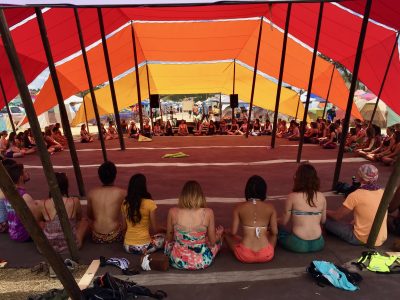Amanda Lucia
Second Project Fellow, Center for Ideas and Society

Department: Religious Studies
Rank: Associate Professor
Years at UCR: 7
Favorite Thing: Building my secret garden.
Top texts for a desert island:
Q. Your research agenda summed up in one sentence:
What do we need to change about our own thinking to make the other people’s “strange”, “ridiculous,” “outrageous,” “insane” ideas begin to seem like common sense?
Q. How does this focus play out in your work?
Each project I work on is particular to its socio-historical context, but in general my research gets close to my subject matter, through the method of ethnography, meaning the practice of participant-observation conducted while living and working among my interlocutors. From these microcontexts, situated in the broader fields of guru studies, modern global Hinduism, and its peripheries, I have tackled theoretical issues related to gender, globalization, whiteness, and power in the guru-disciple relationship.
Q. Can you give us an example of a project that demontrates your approach?
My most recent book, with a working title of, White Utopias: Yoga, Transformational Festivals, and Countercultural Spirituality, is currently under review with the University of California Press. White Utopias is a bold book that questions why countercultural spirituality, in its various forms, has been and remains consistently and predominantly white, despite its proclamation with progressive and anti-racist ideals. The book deconstructs its foundations in religious exoticism, meaning the incorporation of ‘other’ religious forms in a search for authentic meaning, and shows how this translated into contemporary practices of white viscosity (“stickiness”) and cultural appropriation. Using both strategies of empathy and critique, I present my findings as a discordant, ambivalent, and provocatively uncomfortable window into these utopian communities, one that is both euphoric and vexed. My sustained and intensive ethnographic research shows that these fields are both radically transformative for the participants involved and problematically engaged in the logics of white possessivism.
Q. What other ideas do you have brewing?
Recently, I have been writing and writing and more writing! White Utopias took me from New Zealand, to Australia, to Black Rock City (Burning Man), to Quebec, to Joshua Tree, to Switzerland, to Squaw Valley. My eight years of ethnographic research included audio recordings from more than 97 interviews, 74 spiritual workshops, and 52 yoga classes, and infinite porto-potties! This year, it has been a reprieve to step out of the field for the final intensive writing stage. While finishing up White Utopias, I was also pleased to publish an article in the Journal of the American Academy of Religions (JAAR) that leads into my next book project on sexual scandals among celebrity gurus. My article, “Guru Sex: Charisma, Proxemic Desire, and the Haptic Logics of the Guru-Disciple Relationship,” argued that the power dynamics of the guru-disciple relationship couples with the communal belief in the importance of physical proximity to the guru, and creates social environments ripe for sexual abuse (and deterrents to reporting abuse should it occur). For this project, I am the PI for a team of researchers, who have recently been awarded a five-year, $550,000 grant from the Henry Luce Foundation. With these resources, I am very excited to get back to India more frequently for research.
Q. What have you learned from sharing your research into the classroom?
I have been studying countercultural spirituality for nearly my entire life, but it was UCR students that forced me to focus on the overwhelming whiteness of these fields. Discussing these populations at other universities, often times the predominant whiteness of countercultural spirituality went unnoticed, assumed, and unremarkable. It assumed the distinction of white normativity, which enabled these spaces to transcend racialization. But for my UCR students, the whiteness of these fields served as a barrier, a marker of exclusion, and a cultural designation, that rendered them inaccessible, as they were majority non-white identifying students. (In addition, class was another important intersectional aspect that was students often raised.) Because of UCR students, I began to see the that the Orientalist fascination with India, the countercultural “hippies,” and even today’s proliferations of meditation, yoga, and spirituality, are raced and classed in defining ways.
Q. Do you have a favorite podcast or film you urge folks to see?
So many! But right now, I am teaching ethnographic methods and I always encourage my students to see Almost Famous. It’s a great story about the fraught relationships and intimacies on acquires as an ethnographer in the field and the sometimes distressing interpersonal situations that the writing and publishing process can generate.
—
In Focus spotlights faculty associates of the Center for Ideas and Society.

